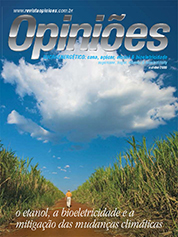José Geraldo Eugênio de França
Executive Director of Embrapa
Op-AA-22
Biofuel and bioelectricity as mitigation tools of climate change
The number of skeptics decreases by the day. It is becoming an accepted reality that significant change in the planet’s climate is occurring and that this time action by man is a preponderant factor. Forest areas are decreasing on almost all continents, glaciers are becoming rare and some say that in 2030 they will no longer exist. Drinking water has, for quite some time, become an object of greed, and like oil, a reason for conflict and lack of cooperation among nations.
For some decades to come, oil will continue to be the main source in the planet’s energy matrix, a factor of wealth and development, and a force capable of accelerating or de-accelerating economic cycles, whether countries have or do not have oil. The most recent discoveries of new reservoirs in Venezuela, Israel, Cuba and Brazil all show that one may not be apocalyptic about the immediate exhaustion of this raw material, even though these new reserves do not confer safety as to the long-term outlook in terms of supply, price and sustainability.
The options are on the table. Some believe that nuclear energy or the development of hydrogen batteries will be the “clean” solutions for the supply of electricity to future generations. In the first case, one knows that notwithstanding technological advancements in the last two decades, the ghosts of Chernobyl and Three Mile Island are still around.
The second option, apart from depending on a great deal of technological refinement, will not be easily available to all countries for applications such as lighting, or industrial or domestic uses. Officially, since 1975, Brazil opted for valuing an alternative path: that of bioenergy and biofuel, while not neglecting its potential to produce hydro-energy or extracting, processing and distributing oil-based products.
With this decision, two crucial issues were dealt with: the sustainable use of land suited for agriculture, followed by the effective use of agricultural technologies developed for food and industrial agriculture. This strategic action is essential for the country as an energy source, bringing about the democratization of income and the interiorization of the country’s development, which began with the conquest of the Cerrado region.
This conquest was acknowledged by Dr. Norman Borlaug, the 1970 Nobel Prize winner who recently passed away, as the largest agricultural revolution to have occurred on the planet since the Green Revolution. Control over greenhouse gas emissions, such as of CO2, and especially of methane, became a strategic element in the world agenda.
Shortly, yet another meeting of countries will take place, this time in Copenhagen, to debate the planet’s future, who pollutes, how much pollution there is, what needs to be done, and more importantly, who should bear the cost of corrections or of using new technologies to be applied in reducing greenhouse gas emissions.
It is in this phase of the debate that the use of bioenergy presents itself as a differentiated factor and an advantage for the country. First, because by viewing the production of fuel as an agricultural activity, such as the cultivation of sugarcane, one shows that no other energy option has such a positive emissions balance as this one.
Second, from the emissions point of view, Embrapa scientists’ studies, and studies of other institutions, show that when using ethanol as fuel in cars, one reduces CO2 emissions to the atmosphere by up to 80%. This figure is quite enviable, under any point of view, in a comparison with any current option. The advantages from the environmental point of view do not end there.
One should point out that, with the current technologies, the ratio between energy “input” and “output” when transforming sugar-cane into ethanol, is 1:9. This efficiency level will not be restricted to this already highly positive ratio, given that for first generation ethanol alone, one estimates that in the next two decades agricultural productivity will increase by 25%, reaching a level of 100 t/ha year, whereas industrial productivity will grow by 15%, resulting in that an efficient distillery may produce on average 110 liters of ethanol per ton of crushed cane.
In this case, even with the first generation of ethanol, Brazilian productivity will escalate from 7,000 l to 10,000 l/year. The third phase of energy productivity gains with bioenergy lies in cogeneration and the production of charcoal and briquettes from sugarcane bagasse. Only recently did bagasse become a by-product in the sugar and alcohol industry, with recognized economic and environmental value.
With the utilization of more efficient boilers and reactors, more efficient energy distribution systems and rising prices of energy used in domestic and industrial applications, cogeneration became an economic and environmental option for several companies in the industry. In the case of Brazil, the consumption of charcoal, domestically and industrially, is another reason for concern, given that its production, in most cases, takes place using native vegetation.
Bagasse and sugarcane straw are better options in terms of income, reduction in deforestation, and the mitigation of greenhouse gas emissions. Bioenergy is not a solution for all problems. However, in the case of tropical countries, with under-utilized agricultural areas, it becomes a logical option from economic, social and environmental points of view.




